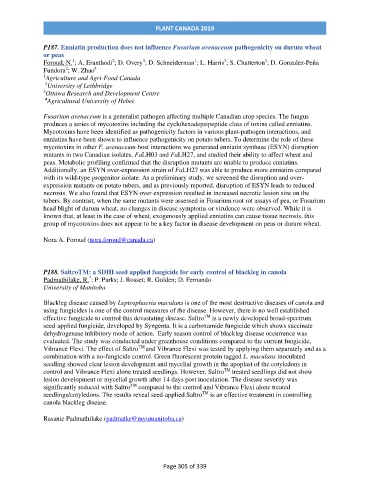Page 307 - PC2019 Program & Proceedings
P. 307
PLANT CANADA 2019
P187. Enniatin production does not influence Fusarium avenaceum pathogenicity on durum wheat
or peas
1
1
2
3
1
3
Foroud, N. ; A. Eranthodi ; D. Overy ; D. Schneiderman ; L. Harris ; S. Chatterton ; D. Gonzalez-Peña
2
Fundora ; W. Zhao
4
1 Agriculture and Agri-Food Canada
University of Lethbridge
2
3 Ottawa Research and Development Centre
4
Agricultural University of Hebei
Fusarium avenaceum is a generalist pathogen affecting multiple Canadian crop species. The fungus
produces a series of mycotoxins including the cyclohexadepsipeptide class of toxins called enniatins.
Mycotoxins have been identified as pathogenicity factors in various plant-pathogen interactions, and
enniatins have been shown to influence pathogenicity on potato tubers. To determine the role of these
mycotoxins in other F. avenaceum-host interactions we generated enniatin synthase (ESYN) disruption
mutants in two Canadian isolates, FaLH03 and FaLH27, and studied their ability to affect wheat and
peas. Metabolic profiling confirmed that the disruption mutants are unable to produce enniatins.
Additionally, an ESYN over-expression strain of FaLH27 was able to produce more enniatins compared
with its wild-type progenitor isolate. As a preliminary study, we screened the disruption and over-
expression mutants on potato tubers, and as previously reported, disruption of ESYN leads to reduced
necrosis. We also found that ESYN over-expression resulted in increased necrotic lesion size on the
tubers. By contrast, when the same mutants were assessed in Fusarium root rot assays of pea, or Fusarium
head blight of durum wheat, no changes in disease symptoms or virulence were observed. While it is
known that, at least in the case of wheat, exogenously applied enniatins can cause tissue necrosis, this
group of mycotoxins does not appear to be a key factor in disease development on peas or durum wheat.
Nora A. Foroud (nora.foroud@canada.ca)
P188. SaltroTM: a SDHI seed applied fungicide for early control of blackleg in canola
*
Padmathilake, R. ; P. Parks; J. Rosset; R. Gulden; D. Fernando
University of Manitoba
Blackleg disease caused by Leptosphaeria maculans is one of the most destructive diseases of canola and
using fungicides is one of the control measures of the disease. However, there is no well established
TM
effective fungicide to control this devastating disease. Saltro is a newly developed broad-spectrum
seed-applied fungicide, developed by Syngenta. It is a carboxamide fungicide which shows succinate
dehydrogenase inhibitory mode of action. Early season control of blackleg disease occurrence was
evaluated. The study was conducted under greenhouse conditions compared to the current fungicide,
Vibrance Flexi. The effect of Saltro TM and Vibrance Flexi was tested by applying them separately and as a
combination with a no-fungicide control. Green fluorescent protein tagged L. maculans inoculated
seedling showed clear lesion development and mycelial growth in the apoplast of the cotyledons in
control and Vibrance Flexi alone treated seedlings. However, Saltro treated seedlings did not show
TM
lesion development or mycelial growth after 14 days post inoculation. The disease severity was
TM
significantly reduced with Saltro compared to the control and Vibrance Flexi alone treated
TM
seedlings/cotyledons. The results reveal seed-applied Saltro is an effective treatment in controlling
canola blackleg disease.
Rasanie Padmathilake (padmatkr@myumanitoba.ca)
Page 305 of 339

